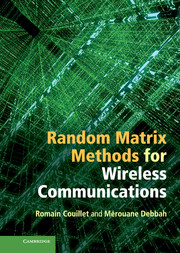Book contents
- Frontmatter
- Contents
- Preface
- Acknowledgments
- Acronyms
- Notation
- 1 Introduction
- Part I Theoretical aspects
- Part II Applications to wireless communications
- 11 Introduction to applications in telecommunications
- 12 System performance of CDMA technologies
- 13 Performance of multiple antenna systems
- 14 Rate performance in multiple access and broadcast channels
- 15 Performance of multi-cellular and relay networks
- 16 Detection
- 17 Estimation
- 18 System modeling
- 19 Perspectives
- 20 Conclusion
- References
- Index
14 - Rate performance in multiple access and broadcast channels
from Part II - Applications to wireless communications
Published online by Cambridge University Press: 07 October 2011
- Frontmatter
- Contents
- Preface
- Acknowledgments
- Acronyms
- Notation
- 1 Introduction
- Part I Theoretical aspects
- Part II Applications to wireless communications
- 11 Introduction to applications in telecommunications
- 12 System performance of CDMA technologies
- 13 Performance of multiple antenna systems
- 14 Rate performance in multiple access and broadcast channels
- 15 Performance of multi-cellular and relay networks
- 16 Detection
- 17 Estimation
- 18 System modeling
- 19 Perspectives
- 20 Conclusion
- References
- Index
Summary
In this chapter, we consider both multiple access channels (MAC), which assume a certain number of users competing for the access to (i.e. to transmit data to) a single resource, and broadcast channels (BC), which assume the opposite scenario where a single transmitter multicasts data to multiple receivers.
The performance of multi-user communications can no longer be assessed from a single capacity parameter, as was the case for point-to-point communications. In a K-user MAC, we must evaluate what vectors (R1, …, RK) of rates, Ri being the data rate transmitted by user i, are achievable, in the sense that simultaneous reliable decoding of all data streams is possible at the receiver. Now, similar to single-user communications, where all rates R less than the capacity C are achievable and therefore define a rate set R = {R, R ≤ C}, for the multiple access channel, we define the multi-dimensional MAC rate region as the set ℛmac of all vectors (R1, …, Rk) such that reliable decoding is possible at the receiver if users 1, …,K transmit, respectively, at rate R1, …, Rk. Similarly, for the broadcast channel, we define the BC rate region ℛbc as the (closed) set of all vectors (R1, …, RK), Ri being now the information data rate received by user i, such that every user can reliably decode its data.
- Type
- Chapter
- Information
- Random Matrix Methods for Wireless Communications , pp. 335 - 368Publisher: Cambridge University PressPrint publication year: 2011



